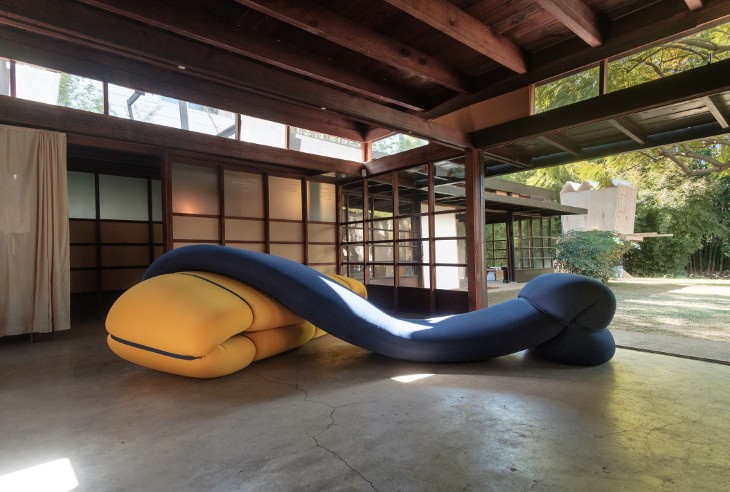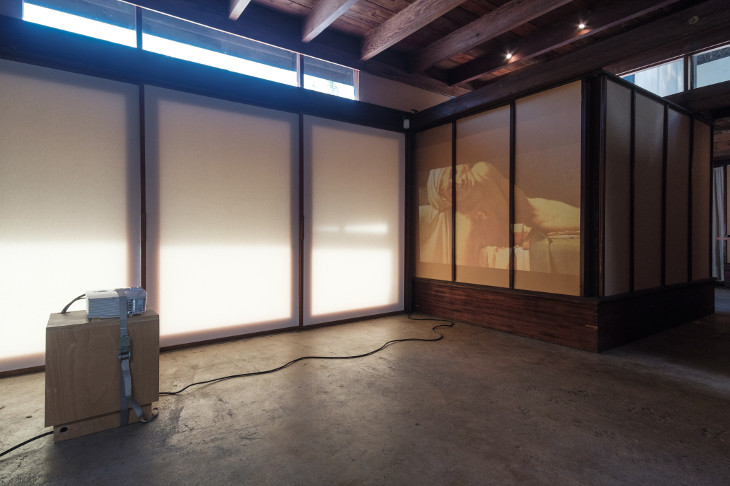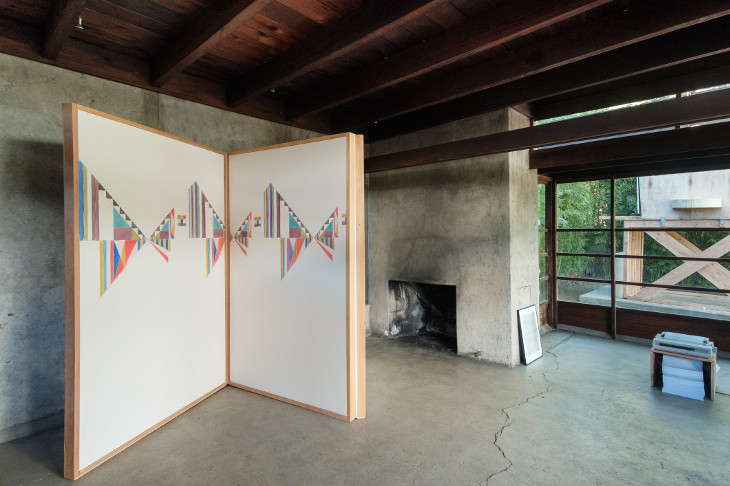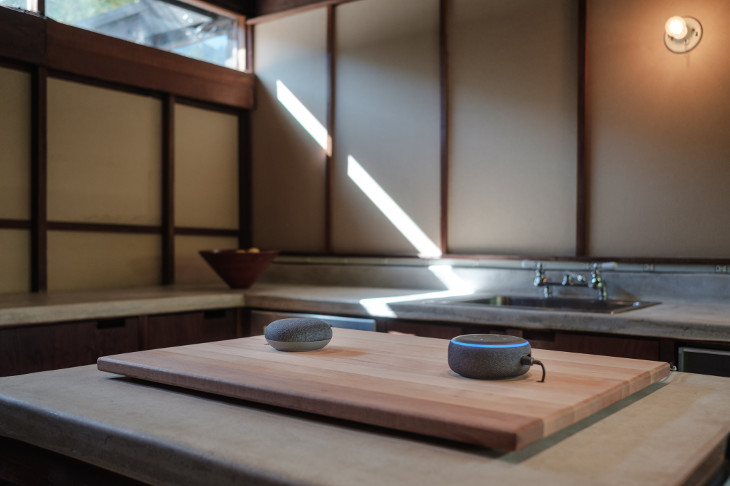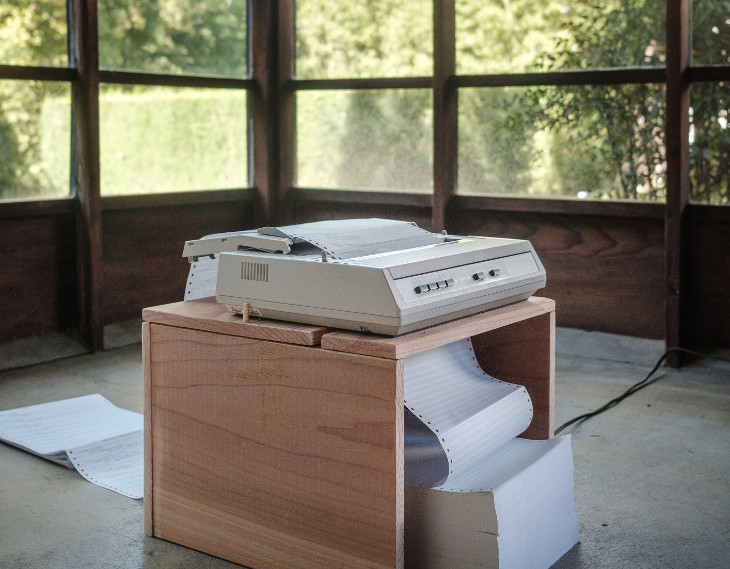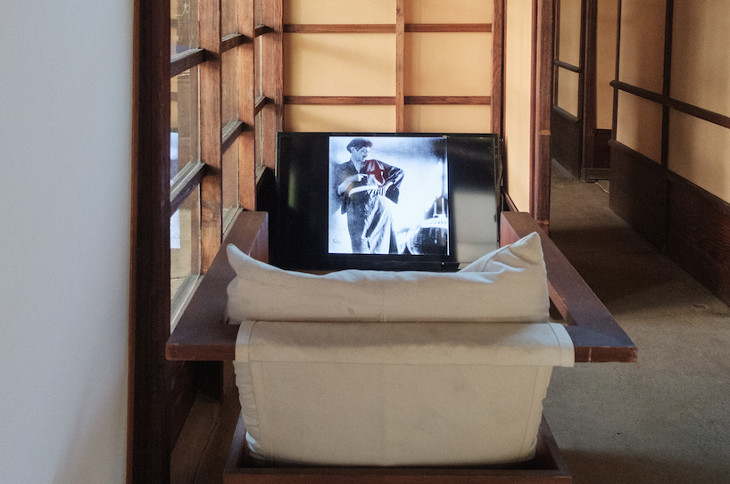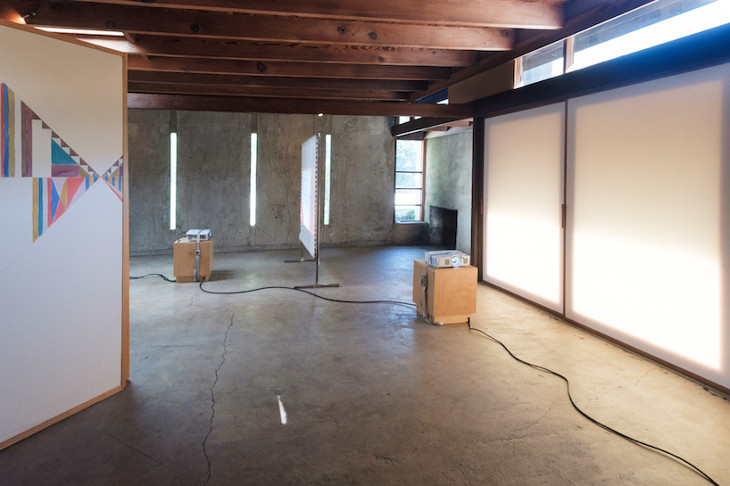Shelter or Playground: The House of Dust at the Schindler House
Exhibition at MAK Center for Art and Architecture, Los Angeles
February 9 – June 2, 2019
Curated by Maud Jacquin, Anna Milone, and Sébastien Pluot, this group exhibition is the result of a collective research effort initiated by Art by Translation with the MAK Center for Art and Architecture and France Los Angeles Exchange (FLAX), in collaboration with the California Institute of the Arts (CalArts).
Shelter or Playground involves the commissioning of new works and performances by Henry Andersen & Bryana Fritz/Slow Reading Club (Australia, USA), Lila Athanasiadou (Netherlands), Jasmin Blasco (France/ USA), Dimitri Chamblas (France), François Dallegret and François Perrin (France), Milka Djordjevich (USA), Daniel Frota (Brazil), Mark Geffriaud (France), Gerard & Kelly (USA), Aurélie Godard (France), Jeff Guess (France), Alison Knowles (USA), Simon Leung (USA) and Luke Stoneham (UK), Lucky Dragons (USA). It is accompanied by interpretations of scores by Fluxus artists or those associated with Fluxus — Alison Knowles, Yoko Ono, Alvin Lucier, Pauline Oliveros — interpreted by CalArts students and by historical performances including works by Merce Cunningham and Trisha Brown on the Nomad Floor by CalArts. The floor plays the role of a contemporary House of Dust, open to anyone upon registration on the MAK Center website, to be used as a studio, rehearsal space, gallery, platform for discussion, etc.
This exhibition organizes an encounter between The House of Dust by Alison Knowles and the Schindler House, two generative architectural projects respectively from the 1920s and 1960s that sheltered experimental performances and served as playgrounds for emancipatory practices and behaviors. Contradicting a functionalist conception of architecture according to which space is designed to control and regulate human activity, both Schindler and Knowles promoted the idea of living spaces that “grow with [their] inhabitants”. According to them, architecture should be treated as an evolving and malleable tool responding to individual and collective needs. In Schindler’s words: “the sense for the perception of architecture is not the eyes – but living. Our life is its image.”
Today, artists have been invited to produce site-specific works by responding to both The House of Dust and the Schindler House. The projects in this exhibition extend the ethos of Knowles and Schindler by exploring the underlying relationships between poetry, architecture, technology, and performance and the processes of translation that animate the convergence of these forms.
The House of Dust is a seminal yet under-recognized work by Fluxus artist Alison Knowles started in 1967 as one of the first computer-generated poems. Each quatrain began with “A House of ...” followed by random sequences of materials, sites or locations, light sources, and categories of inhabitants. Using a cybernetic tool to produce chance operations was opposing its initial goal to control language and human behavior. In 1969, Knowles translated one of the quatrains into two architectural structures with organic, “non-Euclidean” shapes that, at the time, were in contrast with the technological origin of the poem. Originally called The Play House, the houses were installed in two successive contexts: first Chelsea, New York then Los Angeles. Knowles created various protocols for the forms, textures and colors of the Houses to be modified, usually through the participation of different local communities.
In Chelsea, she invited the composer Max Neuhaus who designed a sound piece that converted the light into sound, transforming the house into a musical instrument. The House of Dust was performed for two weeks until angry neighbours set it on fire.
In 1970, Alison Knowles was invited to teach at CalArts by Allan Kaprow. She moved her House of Dust to the campus where it met an outstanding community of artists and students. The architecture became an informal gathering place to smoke marijuana and have sex and was nicknamed “The House of Lust” by CalArts students. The house was an open structure, a platform used to generate and shelter experimental artistic works (installations, performances, dance, concerts, poetry classes, etc.) away from the main modernist building. Matt Mullican offered an event related to food; Michael Bell organized a poetry class and naked meditation sessions; Alison Knowles performed a “gift event” with 99 red apples and Norman Kaplan organized the performance Poem Drop throwing print-outs of the poem from a helicopter, etc.
Housing performances and radical political thinking was also part of Kings Road life. Schindler designed the West Hollywood house for a communal lifestyle for two couples, occasional guests, and as a platform for social and cultural events. And indeed, during the 1920s and 1930s the Sunday parties at the Schindler House became legendary in Los Angeles. Kings road was a burgeoning meeting place for avant-garde artists, play writers and communist activists. The Schindlers and the residents – The Chases and later the Neutras – used to organize events where the architecture housed dance and music performances, poetry readings and political meetings. Pauline Schindler, Dione Neutra and Lloyd Wright played chamber music, John Cage organized japanese flute concerts, Sadakishi Hartmann read poetry and John Bovingdon performed dance with Jeania Marling.
For Pauline Schindler, this social life was fulfilling a dream of cross-pollination of art and radical politics. During the 1920s and 1930s, she organized many political meeting at Kings Road for the communist party, against the spanish war and Nazism in Europe. In 1916, she described her ideal, utopian home, a dream that later came true with the Schindler House: “One of my dreams is to have, some day, a little joy of a bungalow (...) which shall be open just as some people’s hearts are open, to friends of all classes and types. I should like it to be as democratic a meeting place as Hull House, where millionaires and laborers, professors and illiterates, the splendid and the ignoble, meet constantly together.” This portrait echoes Alison Knowles’ utopian architecture whose emancipatory and dehierarchizing features are already present in the randomized use of the computer and the resulting unpredictable encounters between the lines of the poem, exploding the imaginary potential of language.
In a text called Shelter or Playground, Rudolf Schindler described The Kings Road house as follows: “Our rooms will descend close to the ground and the garden will become an integral part of the house. The distinction between the indoors and the out-of-doors will disappear. The walls will be few, thin, and removable. All rooms will become part of an organic unit, instead of being small separate boxes with peepholes... Our house will lose its front-and-back-door aspect. It will cease being a group of dens, some larger ones for social effect, and a few smaller ones (bedrooms) in which to herd the family. Each individual will want a private room to gain a background for his life. He will sleep in the open. A work-and-play room, together with the garden, will satisfy the group needs.”
Schindler and Knowles leave the inhabitants the choice to define the types and qualities of the events happening in the spaces. In both cases, boundaries between inside and outside are blurred; spaces are mutable; they evolve organically and are adjusted according to people’s ways of living. Rather than conceiving architecture as a reified object that reflects the intentions of its creator, they consider the use value of an environment and create spaces where individuals can gather and collectively define a situation.
With these deep and striking conceptual coincidences between The House of Dust and the Schindler House, this exhibition aims to reactivate the generative potential of Knowles’ project at the MAK Center for Art and Architecture in Los Angeles. The contemporary projects explore new, open-ended ways of inhabiting linguistic and physical spaces.
